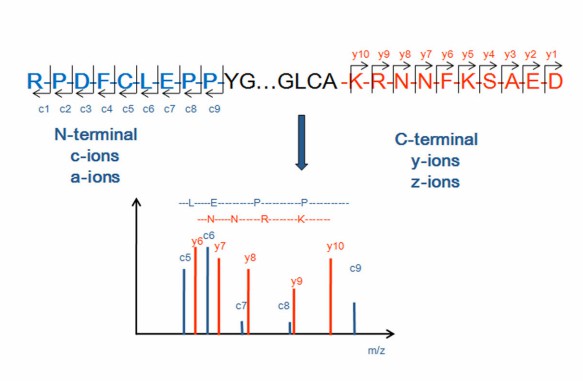Protein C-Terminal Sequencing
- Home
- Services
- Protein Sequencing
- Mass Spectrometry Based Protein Sequencing
- Protein C-Terminal Sequencing
Service Details
The C-terminal sequencing, plays a decisive role in the biological function of proteins, is an important structural and functional part of proteins and polypeptides. In addition, C-terminal modification is also one of the important post-translational modifications of proteins. The current protein sequencing methods mainly include carboxypeptidase method, chemical methods, and tandem mass spectrometr, of which MS/MS has been used to sequence peptides and small proteins for a number of years. This method allows one to isolate the peptide of interest, which makes it possible to analyze impure samples and unseparated mixtures, such as protein digests. Collision-induced dissociation (CID) of the selected peptide generates the productions that provide sequence information.
 Fig. 1. Principles of ISDMALDI MS. (Ejvind Mort,
et al., 2001)
Fig. 1. Principles of ISDMALDI MS. (Ejvind Mort,
et al., 2001)
Creative Proteomics relies on the company's existing mass spectrometry platform to develop a powerful LC-MS/MS system, which is not only suitable for analyzing C-terminal sequences, but also can analyze N-terminal sequences at the same time. which means the N-terminal sequencing and C-terminal sequencing of protein could be determined at the same time in one experiment. This analysis will ultimately be used to confirm whether the recombinant protein is fully expressed, detect whether the recombinant protein is broken during expression, and whether the N-terminal and C-terminal sequences of the recombinant protein are modified.
Based on the C-terminal sequencing services we provide, our customers have achieved good research results in the following applications.
Similar to N-terminal sequencing, mass spectrometry based protein C-terminal sequencing we provide could be achieve 100% coverage of the measured target protein sequence. We first analyze the amino acid sequence information of the target protein and select specific proteases (Trypsin, Chymotrypsin, Asp-N, Glu-C, Lys-C and Lys-N) to digest the target protein separately to obtain protein peptides of suitable length, and then analysis them by mass spectrometry, Then obtain the splicing between peptides while obtaining fragmented peptide.
![]() Fig. 2. Imaged C-terminal sequencing
workflow.
Fig. 2. Imaged C-terminal sequencing
workflow.
Please feel free to contact us If you would like to discuss the best way to determine the C-terminal sequencing of your protein. At Creative Proteomics, we not only provide professional protein C-terminal sequencing service projects for global customers, our scientists can also provide help to design the best solutions according to your specific requirements, and describe them in detailed project reports, we look forward to with your cooperation.
References
For research use only, not intended for any clinical use.